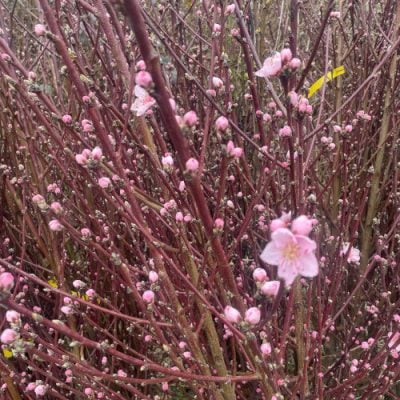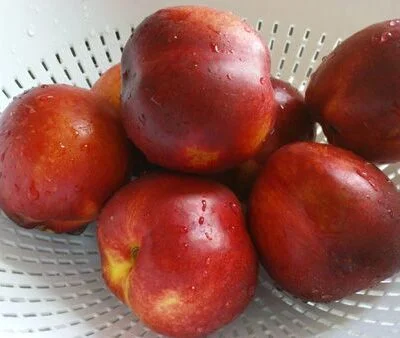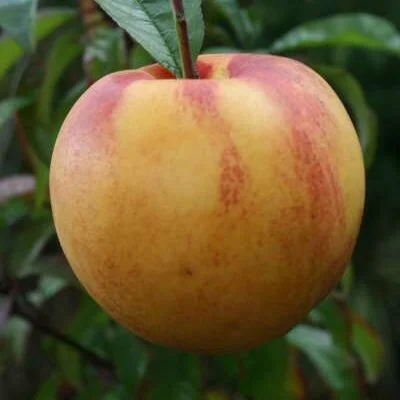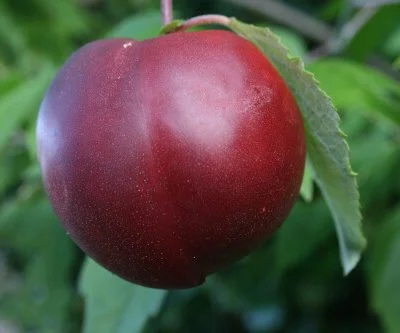Your basket is currently empty!
The two fruits have been combined here in one handy guide because botanically they are almost identical and their cultural requirements are exactly the same. A nectarine tree is after all really only a peach in smooth skin! Peaches and Nectarines are within the scope of all to grow successfully in this country, no matter where you live. The way in which you grow them can be varied according to climate, locality and position but they can be a real triumph and are generally hardier than is often realised. Order quality Peach and Nectarine trees here
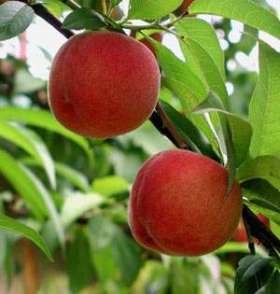
The Peach and Nectarine tree flowers early – second only in this respect to the Apricot – and usually opens blossom from the end of March. For this reason some protection is advisable so that the flowers do not become frosted and if this happens you may lose some or all of your crop. As far as the winter goes well they are usually quite frost tolerant whilst dormant and only extreme or prolonged cold temperatures will harm them.
They can be grown as bush trees in the open in more favourable counties, against a warm sunny wall as ‘fan trained’ and in containers. Or if you have a nice greenhouse, conservatory or sun lounge why not afford them some luxury? Peaches and Nectarines also thrive in containers.
Another added bonus is that these are trees that seem in a hurry to begin cropping – often maiden [1 year old!] trees will have flowers and what a joy it is to see reward for your efforts so soon! It will make you wonder why you delayed growing them for so long.
Yields of over 50ibs from a bush tree have been recorded and even a fan agains a suitable wall can give 30ibs every year – that’s a lot of Peaches! It just goes to show that these are no sulking primadonnas as long as conditions are reasonable.
The flowers are particularly beautiful being a singular rose pink appearing all along the branches in early Spring. Infact did you know the Peach is cultivated on a smalls scale commercially purely for it’s blossoms, the young branches are cut and sold to florists for indoor decoration.
The best position
Is of course the most favourable one you can afford. Soil isn’t very critical as long as it has good drainage and I haven’t found PH to be particularly important. They resent poor drainage and heavy clay soils might be problematical overwinter as the ground gets so cold and wet. Under those conditions better to grow them in containers.The more sunshine your tree gets the better the fruits will be – bigger, rosier, sweeter. The tree will revel in it’s position and ripen more wood to use as flower production for ever greater crops. It is no use growing these trees in the shade.
Soil Preparation & Spacing
Standard soil prep as for most fruit trees is sufficient. It should be nicely friable and dug over to 2 spits if necessary and 1 spit if it has been cultivated recently. A dressing of 2 oz’s bonemeal or blood fish and bone, and 0.5oz’s of potash will give all the feed that is required to get the trees going nicely. An addition of compost or humus rich material spread 2” deep across the planting area will help with the trees’ continued establishment come Spring as it will ensure they don’t dry out so much. It also helps reduce weed infestation; weeds are a no-no when it comes to newly planted trees which require all available moisture, nutrient and strength to re-eetsblish themselves. You don’t want unnecessary competition from thuggish weeds so get rid of them first. If the area hasn’t been cultivated recently and is largely bare then it is a simpler matter to treat it with herbicide. If you have the luxury of time and are preparing in a advance it is a good idea to go over it with a second application 8 weeks later as more weeds will come through wherever the soil has been turned, especially after rain.
You should allow up to 8’ for a traditional bush Peach or Nectarine tree although they can often be contained in a lesser space than that but if you can allocate 8’ then do so. The more the tree is allowed to grow the more fruit it will have! There are two miniature varieties – Garden Lady or Bonanza Peach, and Nectarella Nectarine. These are genetically dwarf which means they simply don’t grow very much. Normally they are top-grafted so you will have a nice clear stem of around 3’ or so with a roughly rounded head on top. These types of tree are enjoyable to grow on the patio and a novel feature. The fruits are moderately sized and well flavoured but understandably cropping is limited on a tree that reaches barely 4’ and much less across. They shouldn’t be viewed as a replacement for a proper tree wherever there is room as the yield, quality and size of the fruit will all be much better.
When to plant Peach and Nectarine trees
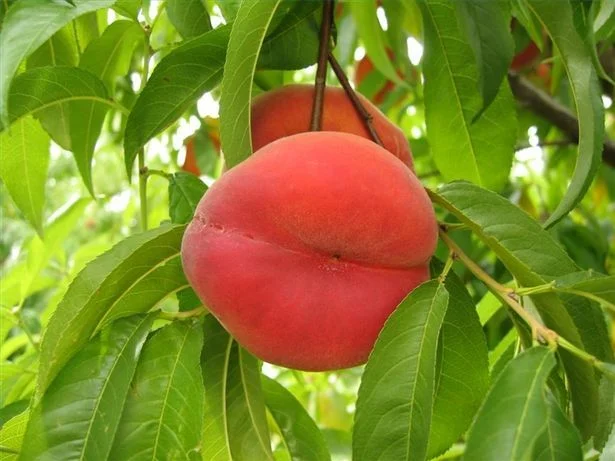
Peach and Nectarine trees can be planted at any time of the year. I can hear the experts amongst you tut tutting because I know that if asked you would point to the Autumn and Winter as being the best time to transplant. It is a good time but it is not the only time and I can assure sunny weather gardeners – or maybe you just weren’t bitten by the bug to plant back in the Winter, or your plot wasn’t ready..,.. it is perfectly permissible to plant from Springtime through Summer as well as long as you start with a container grown plant. During the winter specialist nurseries supply bare rooted stock, and during Summertime they are only ever supplied in pots/containers. A bare rooted tree is often considered easier to transplant because it is dormant and won’t receive any ‘shock’ after transplanting. But you can only lift this type of tree when it is completely dormant. A pot grown tree is a good alternative when the trees are actually in growth and because this type of tree has an established rootball well covered in compost that won’t be disturbed much after transplanting, it is usually successful. More watering is involved with the pot grown tree afterward but I always see this type of tree growing away quite quickly for the rest of the Summer. Imagine if you were made to wait until the following Autumn to plant, having been told ‘it’s too late to plant now’ By then you will have lost months during which time your pot grown tree will have happily been busy making new roots and new growth – already well placed to overwinter and grow away again the next Spring, at which time your bare root tree would only be thinking about making a start!
Planting itself – best practices
Dig a hole large enough to take the roots. The root system can vary quite a lot in size according to variety, Rootstock and the land the tree has been grown on as well as the age of the tree. So don’t dig the holes in advance, wait until you have the tree and can see what you have got to work with. The tree should be planted at a depth similar to that it was set at before on the Nursery; you can usually still see the soil mark on the stem and so use this as a guide. If you can’t maybe the trunk was washed by heavy rain or whatever then sue the grafting point as your guide. The graft is often clearly to be seen as a bulge or kink in the stem not far above the roots. It may still have wax or tree sealant on it as well. This grafting point should always be kept above the soil lebel so make sure it is sitting about 2” above the soil ideally. It should never be buried. The roots themselves should always have not less than 2” of soil over them.
Make sure the tree is firmed in well when you are satisfied with it, use the heel of your boot and press down repeatedly and firmly all around the circumference of the trunk. Peaches and Nectarines do not normally need much of a stake, if the position is an open one then insert a good tree stake of 48” length into the ground before planting. Tie to it with a rubber strap. Tree guards are a necessity where rabbits or deer may be a problem. Spiral tree guards are inexpensive and effective but you may wish to invest in more heavy duty and longer term guards.
The container grown tree is planted in the same way as the bare rooted one but the planting hole should be more or less the same size as the rootball. Place the rootball intact into the hole making sure the top is level with the soil surface or just slightly below it. Replace the soil and again firm very well, so it does not ‘rock’ during high winds. Water in well after planting; it is then necessary to water heavily twice a day for the first 2 or 3 weeks or until established. Keep an eye on it for the rest of the growing season applying extra water when required if the tree looks stressed or droopy. Average rainfall may not be sufficient during this critical period so always be prepared to water heavily – that is with a hose, no sprinkler. Water should be applied direct to the soil around the roots, not sprayed over the top of the tree.
Planting pot grown trees is better employed early or late in the day, rather than during the main part of the day when it is hotter as the tree will endure less stress then.
Planting the fan trained tree
As the area close to a wall is often very dry particular attention should be given to this and copious amounts of water given after planting. The tree itself should be set 15-20” away from the wall and a suitable wire support system should be in place before planting takes place. Galvanised or rubber coated wire is suitable along with eyelets inserted into the wall to thread them through.
Always start with a young tree; Peaches and Nectarines feather strongly the first season so your tree will already look quite substantial.When you receive your new young tree prune it back hard. If it has lower laterals at a suitable point then select two more or less opposite and remove the leader just above them. The height of the first two laterals can be to your own liking, there isn’t a hard and fast rule but 18” is about the norm. Higher or lower is fine too. These two laterals should be gently tied down more or less horizontal. They will form the basis of your fan because next summer lots of strongly growing upright stems will spring for and these will form the basis of your fan. During that summer they should be shortened back by about a third and this will encourage them to shoot again and also initiate fruiting for the following summer. Summer pruning is the time to prune Peach and Nectarine trees.
Never try to grow your fan Peach or Nectarine in a container against a wall. It is never wise to place pots agains sunny walls because they get far too hot in the summer and it is next to impossible to water adequately. Your fan Peach tree should be grown in the ground.
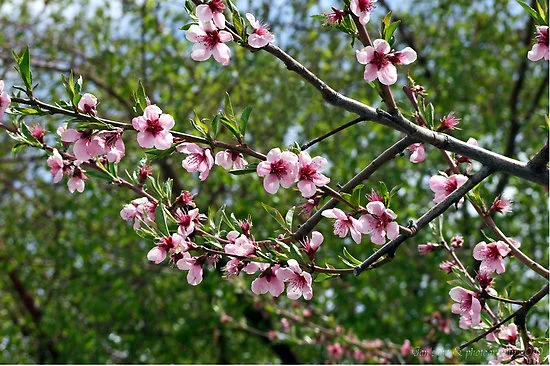
Pruning Bush trees
Immediately after planting, if the tree is a maiden, the main stem should be cut just above a bud at approximately 3 feet from the ground and any side shoots cut back to just 2 or 3 buds from the main stem. These young side shoots are called feathers, any that are closer to the ground than 2 feet should be removed.Thereafter during subsequent seasons select a number of semi mature growths which should be pruned back by about a third each Spring. This encourages strong new growth which is what will bear the fruits next year.
Feeding & aftercare
Peaches and Nectarines seem to appreciate a bit of extra feed, more so than other fruits so for the best results I recommend 30z’s of growmore or bonemeal per square yard raked lightly into the soil in the area surrounding the base of the tree. In addition to this look to providing a good application of liquid dilute tomoato food, every fornight from May to August.Additional irrigation is most important to obtain large, fleshy fruits with plenty of juice. This is especially important for trees grown against walls but is also highly beneficial to bush trees. Give the area around the roots a good soaking every day if possible, or every other day if it has rained appreciably. Use a hosepipe to soak the soil properly and this is best done early in the morning whilst it is still cool. Try to avoid wetting the foliage if possible.
Growing in Containers
These fruit trees are very satisfactory grown in a pot or container and this represents one of the very best ways of cultivation. You can expect a yield almost straight away and the trees growth is naturally controlled.A container of about 24” is ideal, or you can invest ina half barrel but these are less easily mobile if you need to move it. I recommend a loam based compost such as John Innes no 2 as this has more hart or body than peat-based composts which is important for trees as it won’t become impoverished so quickly.
The tree can be planted into a container at any time and whilst most varieties are reasonably hardy bare in mind the roots will be more frost susceptible than those grown in the ground, so be prepared to offer protection with horticultural fleece, or simply move the whole thing into a cold greenhouse or conservatory if severe winter weather threatens. They certainly don’t need to spend the entire winter indoors infact a certain amount of frost is beneficial. The trees like to have a ‘definite’ dormancy period and some frost ripens the wood properly for flower and fruit production.Adequate watering is of course very important as described previously. And regular feeding will not only maintain the trees stamina, it also encourages regular cropping and high quality fruits. Tomato deed and Osmocote tablets used in combination should give excellent results. The Osmocote needs applying just once each season, the tablet pressed into the compost. It is a solow release feed that lasts for a whole season. Replenish in Spring of each year. The tomato feed should be applied fortnightly from May until the fruits start to ripen on the tree.
Re-potting will be necessary after 5/6 years. It is not necessary to increase the size of the container unless you want to; re-pot when dormant and shake off or tease out some of the outer compost and then replant in fresh.
Pruning principals are as described previously but there shouldn’t be any need for too much as growth will be naturally retarded, especially after the first year or two.
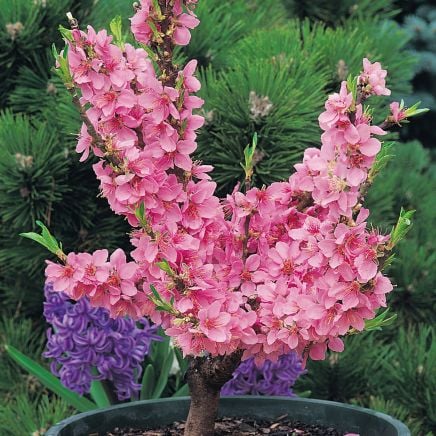
Pests and diseases
There is really only the one significant problem associated with Peach and Ncetarine trees and that is Peach Leaf curl which can and will affect both Peach and Nectarine trees, but does not touch Apricots.It is easily identifiable because the leaves twist, curl and ‘bubble’ and come out in rather alarming red blisters. Sometimes trees can be completely disfigured by it. It looks a lot worse than it is and the best remedy for infected trees is to remove all the affected foliage and destroy it. This can leave a tree almost denuded of foliage but don’t worry, it will quickly leaf again and the new foliage will be ‘clean’ and won’t become infected again that season.
There were effective control sprays for leaf curl but they have been removed, meaning there is only one precautionary measure available to gardeners wishing to avoid this disease. The fungal spores are spread by moisture droplets in the air. Therefore if the tree is kept dry during the key period when these spores are active – which is very early spring just as the tree start to break dormancy – then the problem can largely be eliminated or at least reduced significantly. Bush trees of modest size, fans against a wall, and pot grown trees are fairly easily protected from rain during this essential period. Cover with a transparent material until the leaves are fully open, usually by May it can be removed and the period for infection has passed for another year. That is why trees grown in greenhouses or inside seldom get much if any leaf curl.
Aphids, greenfly and red spider mite may also attack Peach and Nectarine trees. Spray with soapy water, use biological controls, or buy a systemic insecticide or a so called ‘bug gun’ – all will provide effective treatment.
Pollination
There are no pollination issues with Peach and Nectarine at all as all varieties are self fertile and lone trees will provide a good crop with no need for a pollinating partner. The only thing to remember is that trees grown under cover will need hand pollinating with a soft haired brush because there won’t be any flying insects around to do the job for you. Hand pollinating can also increase the yield employed outside, especially if the weather is inclement during flowering and insects may not be on the wing.
Thinning the fruits
This isn’t really a necessary practice unless you want to concentrate the trees energy into a lesser number of larger fruits. This of course has the affect of increased fruit size and the class of the fruit produced. It might be a consideration if your tree seems to be over producing because then you might end up with a lot of smaller fruit which may be no less enjoyable. For gorgeous big ripe fruits of peach and nectarine, remove every other fruit along the branch when about the size of an acorn, allowing the rest to develop to maximum magnificence. Remember that the tree may shed some fruits of it’s own accord, and this is especially true if it becomes dry at the roots during crop formation. The most likely period for this to happen is mid May to mid June.
The best varieties for outdoor cultivation
Are the famous Peregrine,[pictured below] with it’s white fleshed super-sweet fruits, Amsden June, a hardy extra-early variety, and Red Haven which is yellow fleshed and highly coloured with a lovely flavour.
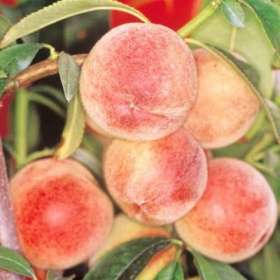
For a greenhouse I recommend Wassenberger, Kestrel, Dymond or Charles Ingouf which is a greenhouse specialist and will produce superb crops, but it should be remembered that any varieties of Peach and Nectarine can be grown indoors.All varieties can eqaully be grown outdoors, depending on position and equally all varieties are suitable for indoor growing so the above are meant as recommendations.



